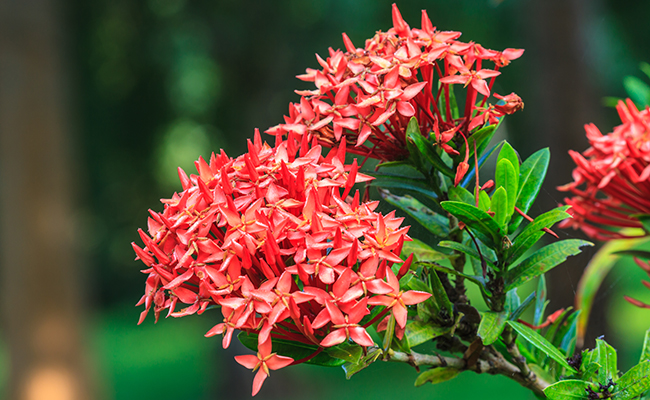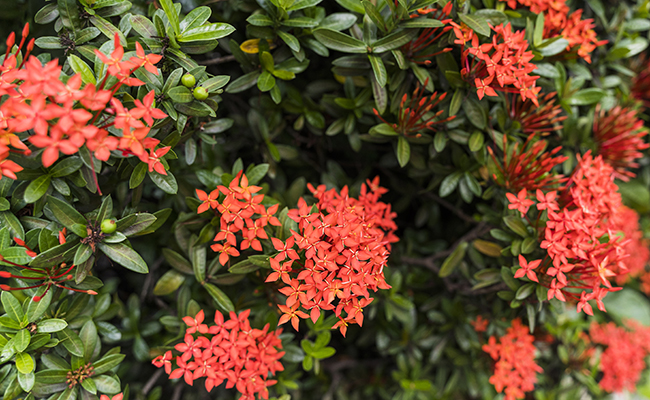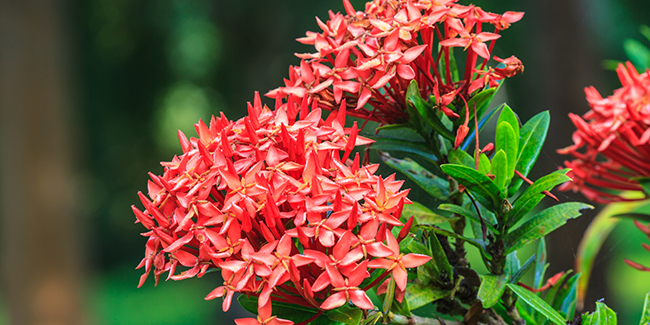The scarlet ixora (Ixora coccinea) also called Japanese hydrangea or torch tree, is a bushy shrub native to the tropical forests and mountains of Southeast Asia, but its chilliness is such (4°C minimum) that it becomes an indoor plant in our latitudes Europeans.

Its evergreen leaves, medium to dark green, opposite, oblong or obovate, elliptical, glossy, leathery, measure 5 to 10cm long and form a fairly dense rounded shrub.
From May or June until October, the ixora produces long flattened flowers 3 to 4cm long and 1cm in diameter, with 4 petals, gathered in numerous terminal corymbiform cymes from 5 to 12cm in diameter, brightly colored: red, orange, pink, yellow or white, depending on the cultivar. Its flowers are fragrant and nectariferous
Among the indoor flowering plants, the ixora is one of the bathroom plants where the high humidity will satisfy it, provided that a window is pierced there of course.
In India, ixora has medicinal benefits since it treats eczema and other minor skin problems. As for its wood, it served as a torch, hence the name torch tree.
- Family: Rubiaceae
- Type: flowering houseplant
- Origin: Southeast Asia
- Color: red, orange, pink, yellow or white flowers
- Sowing: no
- Cutting: yes
- Planting: spring
- Flowering: May to October
- Height: up to 1.5 m (as much in spreading)
Ideal soil and exposure for the ixora
Ixora is grown warm (18-25°C) in full light, avoiding direct scorching sun and drafts, in rich, cool, fairly acidic or neutral, well-drained soil. The pot can be placed on a saucer lined with clay pebbles or gravel to increase the atmospheric humidity.
Date of cuttings and repotting of the ixora
It is in August that you will undertake cuttings of semi-woody stems, steamed in the heat, at a minimum of 25°C. Your patience can sometimes be rewarded after 2 months of waiting!
Generally, the average growth of the ixora only requires repotting every 3 years, to be done in the spring. When the shrub becomes too bulky, surfacing will suffice.
Board of maintenance and culture of the ixora
Waterings with non-calcareous water at room temperature must be regular during the growth period, favoring generous waterings, renewing only when the substrate has dried to a depth of 3cm. In winter, they will be a little more spaced out.
The pruning that is done after flowering has no other purpose than to maintain a balanced habit for the shrub.
Diseases, pests and parasites of ixora
The ixora is sensitive to mealybug attacks, because of the excessively dry air in our interiors.

Location and favorable association of the ixora
It is a plant that is grown indoors, rather in a piece of water like the bathroom if it has an opening to the west or south (behind a curtain). It also finds its place in greenhouse or veranda.
Elsewhere, in the tropics, the Japanese hydrangea creates very pretty hedges.
Recommended species and varieties of Ixora for planting in the garden
Genre Ixora has nearly 400 species in total but the scarlet ixora (Ixora coccinea) and its many cultivars are unquestionably the stars of garden centres. Among these, let us point out ‘Super Kings’compact, with red flowers, ‘Angela Busman’compact, with shrimp-pink flowers, Frances Perrywith dark yellow flowers, ‘Frasery’salmon pink flowers, ‘Helen Dunaway’with dark orange flowers, ‘Herrera’s White’with white flowers…
Ixora chinensis is another species, originating from China, a little less tall but quite similar to the Japanese hydrangea.
